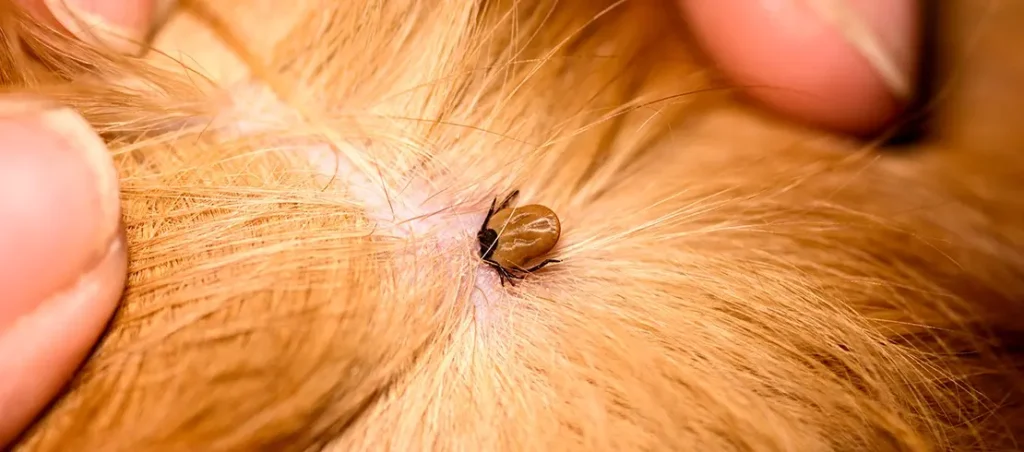Ticks are a common issue for dog owners, especially during the warmer months, when these tiny parasites are most active. From my own experience working with expert veterinary care at Southeast Oakville Veterinary Hospital, Oakville, ON, I’ve seen how an embedded tick often looks like a small bump on the skin and can cause serious health problems if not addressed promptly. There are risks associated with tick bites, so it’s essential to seek professional help to prevent infections and ensure proper removal. If you ever suspect your pet has a tick, getting it checked by a vet immediately can make all the difference in protecting your furry friend’s well-being.

Understanding Ticks and Their Behavior
Ticks are small arachnids closely related to spiders, and from my experience, they tend to thrive in wooded areas, tall grasses, and places with abundant wildlife. These parasites attach to hosts like dogs to feed on their blood, often staying attached and embedded for several days until they become engorged. When I’ve helped pet owners spot them, they’re often surprised at how well ticks hide within a dog’s fur or skin folds, appearing as small bumps until they swell after feeding.
The Life Cycle of a Tick
Ticks go through four life stages: egg, larva, nymph, and adult, and in my experience dealing with tick issues in dogs, each stage is surprisingly resilient. What many pet owners don’t realize is that each stage requires a blood meal to progress to the next, often making dogs an easy target. By understanding their life cycle, it becomes much easier to spot when your pet might be at risk and take steps toward identifying and preventing tick infestations before they become a serious problem.
Identifying an Embedded Tick on Your Dog
Recognizing an embedded tick is crucial for your dog’s health. Ticks can transmit diseases, so early detection and removal are vital.
Appearance of an Embedded Tick
An embedded tick on a dog can vary in appearance depending on the type and how long it has been attached. At first, it may look like a small, flat speck, but as it feeds, it becomes more noticeable in size and shape. I’ve often seen them resemble a sesame seed, and as they engorge, they can swell to the size of a pea or larger. Their color may range from brown, black, or reddish when fresh, to engorged gray or pale when full of blood. The location where ticks attach is often in hidden areas like behind the ears, between the toes, or under collars, making careful inspection important after outdoor activities.
Signs of an Embedded Tick
When it comes to visual identification of an embedded tick on a dog, the signs can be subtle at first but become clearer over time. You might notice your pet scratching or biting at the site where the tick is attached, often showing redness and swelling in the area. The skin may appear red or swollen, and in some cases, small scabs, crusts, or crusty skin may form as a reaction. From my experience, carefully parting the fur and checking these irritated spots helps catch ticks early before they cause discomfort or infections.
Risks Associated with Tick Bites
Tick bites can lead to serious health issues in your dog, which is why understanding the importance of early detection is key. From my own experience, even a small tick can pose risks if not noticed quickly. Watching for unusual skin changes, scratching, or swelling helps catch them before problems grow. Seeking professional veterinary care right away ensures safe removal and prevents infections or tick-borne illnesses, keeping your pet healthy and comfortable.
Disease Transmission
From my years of handling tick bites in pets, I’ve seen how ticks act as vectors that spread serious diseases affecting a dog’s overall health. When a tick carrying the bacterium Borrelia burgdorferi attaches, it can lead to Lyme disease, which often causes joint pain, fever, and lethargy. Another dangerous bacterial infection known as Anaplasmosis can trigger similar symptoms, while Ehrlichiosis may manifest with abnormal bleeding and fatigue. That’s why I stress the importance of early detection and seeking professional veterinary care immediately—these risks increase the longer the tick stays embedded, making prompt removal and medical attention vital for preventing long-term issues.
Local Reactions and Infections
In my experience treating dogs with tick bites, I’ve often noticed localized reactions that appear soon after the bite site is irritated. The surrounding skin may swell, turn red, or itch, and in some cases, small infections can develop if the area isn’t cleaned properly. Sometimes, persistent inflammation may lead to firm lumps called granulomas, which take time to heal and may cause discomfort to the dog. This is why it’s crucial to monitor the area after removing a tick and seek proper veterinary care to prevent complications.
Prevention and Control of Ticks
To protect your dog from tick-borne diseases, it’s vital to focus on preventing tick bites using smart strategies. From my own experience, regular checks after time spent outdoors, especially in hidden areas like the ears and collar, can catch ticks early. Using veterinarian-recommended prevention products such as topical treatments that kill on contact, oral medications that offer systemic protection, and collars that repel ticks adds extra safety. Maintaining environmental control is just as important — keep your yard tidy by mowing grass, removing leaf litter and debris, and using fencing to stop wildlife from entering, all of which lower the risk of infestations.
When to Seek Veterinary Help
If your dog has an embedded tick, it’s crucial not to panic but to act wisely. Many pet owners try to remove the tick themselves, but doing it incorrectly can cause serious problems. When the tick’s parts remain under the skin, it can result in swelling, redness, or even an infection, sometimes leading to discomfort or more severe health complications. From my experience, the safest option is to always reach out for professional veterinary help, as veterinarians have the right tools and methods to extract the tick completely without hurting your pet.
I’ve seen cases where well-meaning owners tried to handle a tick removal at home, but the tick’s head stayed buried, creating a painful sore. This is why recognizing when to call a vet is so important. Getting prompt care ensures that your dog heals properly, avoids infections, and prevents further irritation around the bite area. Remember, even a small tick can cause big trouble if not handled correctly.
Professional Tick Removal
Veterinarians use specialized tools and techniques to remove ticks safely and completely, ensuring no part of the parasite is left behind. From my personal experience, seeking professional help gives peace of mind because vets can also check for signs of tick-borne diseases that may not be visible right away. They provide the most appropriate treatment if an infection is detected, helping your dog recover quickly and preventing further health problems.
Monitoring for Symptoms
After tick removal, it’s important to monitor your dog closely for any signs of illness. From my experience, even a small change in behavior can reveal early symptoms like fever, lethargy, or joint pain—all of which may suggest a tick-borne infection. Always trust your instincts as a pet owner; if something feels off, contact your veterinarian immediately. Quick action ensures your dog gets the right treatment and prevents the condition from worsening.
Protecting Your Dog from Tick-Borne Diseases
Ticks pose significant health risks to dogs, especially during warm seasons when they are most active. From my experience, early detection and professional care can greatly reduce these risks. I always advise pet owners to perform regular tick checks after outdoor walks and use preventative products recommended by their vet to keep their pets safe. Environmental control also plays a major role—keeping your lawn trimmed, removing leaf piles, and reducing wildlife access can help limit tick populations around your home.
If you ever find an embedded tick on your dog, don’t panic but act fast. Reach out to Southeast Oakville Veterinary Hospital in Oakville, ON, where expert care is available to safely remove the tick and check for possible infections. Their compassionate team ensures your dog’s well-being and happiness while helping you learn the best ways to prevent future tick issues.
How do you tell if a tick is embedded in your dog?
You can often tell a tick is embedded in your dog by watching for scratching or biting at a specific site where the tick is attached. From my grooming experience, I’ve noticed that the area around it may turn red, appear swollen, or show redness and swelling over time. Sometimes, you may even find small scabs, crusts, or crusty spots on the skin that signal irritation. When my own dog began to scratch and bite more than usual, I checked closely and found a hidden tick under the fur—proving how these tiny pests can easily go unnoticed.
How long can a tick stay embedded in a dog?
The length of time a tick stays attached to your dog depends on several factors such as the species, life stage, and the host’s immunity. From my experience in regular pet care, a daily check helps spot ticks early before they remain undisturbed for too long. Larvae can stay feeding for a few days, while nymphs and adult females may cling on even longer if unnoticed. Keeping up with routine grooming and outdoor inspections makes it easier to detect and remove ticks before they cause problems.
What does a tick look like when it’s inside a dog?
When a tick is deep in a dog’s skin, its body often appears as a small bump that may look brown or grey-ish in colour. From what I’ve seen during grooming, the area around it can turn red and slightly swollen, especially if the tick has been engorged with blood for some time. The size of the tick usually varies, depending on how long it has been feeding. Sometimes, it blends into the fur, making it tricky to spot until the dog starts scratching that irritated spot.
Should I remove an embedded tick from my dog?
Yes, you should remove an embedded tick from your dog as soon as possible. From my own experience as a pet owner, the longer a tick stays attached, the higher the risk of it transmitting harmful tick-borne illnesses. I once noticed a tick deeply embedded in my dog’s fur after a walk in the woods, and quick action made all the difference. Using fine-tipped tweezers and gentle hands, I carefully pulled it out without squeezing it, preventing the spread of infection. Acting promptly not only eases your dog’s discomfort but also reduces the chances of serious health problems that could arise if the tick is left in place.
